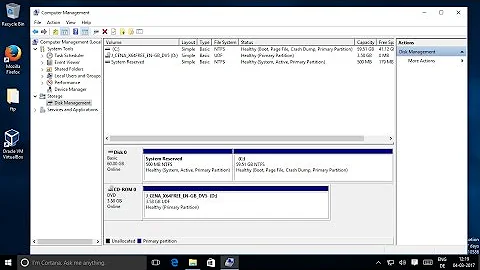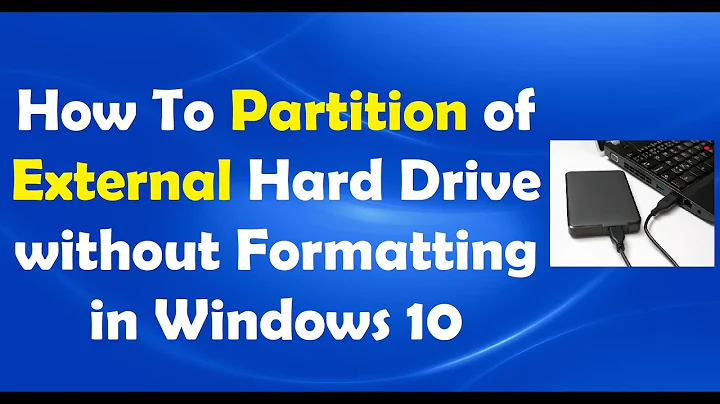Partitioning an external HDD using GPT and with a "Microsoft Reserved" partition?
A Microsoft Reserved Partition, or MSR, is a partition of a data storage device, which is created simply to reserve a chunk of disk space for possible subsequent use by the operating system software of a Windows operating system. No data is stored within the MSR; Windows may take from the MSR partition for the creation of new partitions, which themselves may contain data structures. (Wikipedia)
You need it only if you plan to use the disk as a Windows system disk. It is not needed on a Windows data disk.
The GRUB partition does not need to be the first one.
If you plan to boot from this disk under UEFI you need an EFI System Partition, formatted FAT32 (
vfatin Linux terminology). This is in addition from any/bootpartition.
Related videos on Youtube
Baard Kopperud
38 yo male from Lillehammer in Norway. Interested in computers, Internet, programming, web-design and electronics. Watch lots of TV. Love to read fanfiction.
Updated on September 18, 2022Comments
-
Baard Kopperud over 1 year
I've just bought a 4TB external HDD, and need some advice before partitioning it. Usually I just delete everything and partition (and create filesystems) from scratch, but this time I really needed to store some stuff, so I'll have to re-size (with
gparted) instead...The HDD uses GPT boot-label. Apart from one 3.7TB NTFS-partition, it also got a small "Microsoft Reserved"-partition (which I don't know quite what to do with... mostly because I don't know what it's for).
From
cfdisk:Disk: /dev/sdd Size: 3,7 TiB, 4000787025920 bytes, 7814037160 sectors Label: gpt, identifier: 9669F8EF-29AA-4A5C-8AE3-FD452B079B46 Device Start End Sectors Size Type /dev/sdd1 34 262177 262144 128M Microsoft reserved /dev/sdd2 264192 7814035455 7813771264 3,7T Microsoft basic dataI will mostly be using the drive with Linux, but I may occasionally use it with Windows too.
I plan to shrink the current large NTFS-partition to free-up most of the drive. I'll also plan to add a small FAT-partition. The rest will be used for several EXT4-partition.
I'd also like to make the drive bootable - and install GRUB - so I can (optionally) install some distros on some of the EXT4-partition (I'd like the option).
Problem is that I'm not very familiar with GPT. I've usually used the old-style DOS/MBR label, but can't this time since I've already started to use the drive.
I saw some tips in the Gentto handbook:
Partition Filesystem Size Description /dev/sda1 (bootloader) 2M BIOS boot partition /dev/sda2 ext2 (or vfat) 128M Boot partition /dev/sda3 (swap) 512M+ Swap partition /dev/sda4 ext4 Rest Root partition
and:
(parted)print Model: Virtio Block Device (virtblk) Disk /dev/sda: 20480MiB Sector size (logical/physical): 512B/512B Partition Table: gpt Number Start End Size File system Name Flags 1 1.00MiB 3.00MiB 2.00MiB grub bios_grub 2 3.00MiB 131MiB 128MiB boot boot 3 131MiB 643MiB 512MiB swap 4 643MiB 20479MiB 19836MiB rootfs
I guess I can drop #2 (/dev/sda2), since that is the boot-partition and I'll rather take my chances with just a root-partition instead.
I'll obviously need to create a grub-partition so I can install the bootloader.
But what about my external HDD's current 1st partition (/dev/sdd1) - the "Microsoft reserved" partition? Do I need it (remember, I may want to use the drive for Windows too)? May there be something interesting on it already (from the drive manufacture) I should keep/save? Or can I just delete it?
If I must keep the "Microsoft reserved" partition, must it be the first partition on the drive - or can it be the 2nd? What about the grub-partition - must it be the 1st partition on the drive, or can it be anywhere (ie. after "MS reserved") as long as the correct flags are set?
So what I'd like to end-up with, are something like the following:
/dev/sdd1 GRUB (bootloader) /dev/sdd2 Microsoft Reserved (unless I can just delete it) /dev/sdd3 NTFS (shrunk down by a lot - 200-500GB) /dev/sdd4 FAT (small - just 50-200GB) /dev/sdd5 EXT4 (200-500GB) /dev/sdd.. Several more EXT4 partitions... ... ...
So to repeat my questions:
1) Does the "Microsoft Reserved" partition serve a purpose, what is it, and do I need it (or can I just remove it)?
2) If I do need it (or even if I don't), must it be first on the HDD - or can it be 2nd (after the boot-loader)?
3) Must the GRUB-partition (boot-loader) be the first partition on the drive, or can it be anywhere if I set the correct flags? (At worst, it'll be 2nd, after "MS reserved".)
4) Are there any other exceptionally unwise things I've proposed doing?
-
Baard Kopperud over 7 yearsCould I move/recreate the MS Reserved partition, or must it be first on the disk? Could I for example put it after the NTFS-partition (eg. GRUB, NTFS, MSRes, Ext4, Ext4, ...)
-
 AlexP over 7 years@BaardKopperud: Yes. The question is why do you need one NTFS partition? If this disk will be used Windows as a data disk then you do not needs a MSR partition at all; if this disk will be used to boot Windows then you should really let the Windows installer do its thing.
AlexP over 7 years@BaardKopperud: Yes. The question is why do you need one NTFS partition? If this disk will be used Windows as a data disk then you do not needs a MSR partition at all; if this disk will be used to boot Windows then you should really let the Windows installer do its thing. -
BenKoshy almost 6 yearsif the HDD is only to be used for Ubuntu then can this MSR thing be removed? (I have another HDD solely dedicated for Windows)
-
 AlexP almost 6 years@BKSpurgeon: Linux (including Ubuntu) does not use it in any way. Only Windows uses it (as a reserve of disk space), but only on a system disk.
AlexP almost 6 years@BKSpurgeon: Linux (including Ubuntu) does not use it in any way. Only Windows uses it (as a reserve of disk space), but only on a system disk. -
Motivated over 5 years@AlexP - Why would an external hard drive allocated a Microsoft Reserved Partition? What do you mean by "system disk" and "data disk"? What do you mean by "subsequent use by the operating system software of a Windows operating system"?
-
Motivated over 5 years@AlexP - Thanks. Do you mean that a system disk is the partition that holds the bootloader? I take it that data disk is a partition to store files other than those required by the operating system or is a hybrid? For example, would it be files such as program files, application specific files and/or personal files e.g. Microsoft Word documents?
-
Motivated over 5 years@AlexP - Why would an external drive have a system partition? I would not expect an external drive to boot.
-
Motivated over 5 years@AlexP - Why would it have the label "Microsoft Reserved" as opposed to NTFS/exFAT/HPFS?
-
 AlexP over 5 years@Motivated: It's not a label, it's a partition type, identified by GUID E3C9E316-0B5C-4DB8-817D-F92DF00215AE. It does not contain a filesystem (NTFS or whatever); in fact it does not contain any data at all, unless by accident.
AlexP over 5 years@Motivated: It's not a label, it's a partition type, identified by GUID E3C9E316-0B5C-4DB8-817D-F92DF00215AE. It does not contain a filesystem (NTFS or whatever); in fact it does not contain any data at all, unless by accident. -
Motivated over 5 years@AlexP - Apologies AlexP. It is confusing. If it a partition type, why is not considered to be a filesystem? Additionally, if it isn't a filesystem how can it be considered to be a system drive (assuming my preceding understanding is correct)?
-
 AlexP over 5 years@Motivated: A partition is a contiguous number of blocks on a disk. It may contain a filesystem, it may contain some other kind of data structure (for example, a chunk of an Oracle database, or a LVM physical disk), or it may not contain any data at all. A partition type is metadata associated with the partition itself, and does not have any necessary relationship with the contents of the partition. And finally, the disk is a system disk; in particular, on Windows, the system disk is the disk with the partition containing the NTFS filesystem with the directory %SYSTEMROOT%.
AlexP over 5 years@Motivated: A partition is a contiguous number of blocks on a disk. It may contain a filesystem, it may contain some other kind of data structure (for example, a chunk of an Oracle database, or a LVM physical disk), or it may not contain any data at all. A partition type is metadata associated with the partition itself, and does not have any necessary relationship with the contents of the partition. And finally, the disk is a system disk; in particular, on Windows, the system disk is the disk with the partition containing the NTFS filesystem with the directory %SYSTEMROOT%. -
Motivated over 5 years@Thanks AlexP. That's clear. I would have thought that for any data structure to exist, the partition must have a filesystem. Is it still considered to be a system disk if it does not have the directory %SYSTEMROOT%?
-
 AlexP over 5 years@Motivated: By definition, Windows considers the system disk to be the disk which contains %SYSTEMROOT% (which is usually C:\Windows). (Actually, it's more complicated, but it's good enough for an introduction.) Enter
AlexP over 5 years@Motivated: By definition, Windows considers the system disk to be the disk which contains %SYSTEMROOT% (which is usually C:\Windows). (Actually, it's more complicated, but it's good enough for an introduction.) Enterset systemat a command prompt to see the current values of %SYSTEMDRIVE% and %SYSTEMROOT%.





